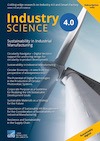Search


Bibtex
Cite as text
@Article{Köters+Schürmeyer+Prange,
Cite-key = "Koeters2024Sus",
Year= "2024",
Number= "1",
Volume= "Industry 4.0 Science 40",
Pages= "70-75",
Journal = "Industry 4.0 Science",
Title= "Sustainable Food Supply Chains Through Artificial Intelligence – Conceptual visualization using the example of turkeys to promote animal welfare and food quality",
Author= "Corinna Köters, Hochschule Niederrhein University of Applied Sciences and Witten/Herdecke University; Maik Schürmeyer, Hochschule Niederrhein University
of Applied Sciences; Alexander Prange, Hochschule Niederrhein University of Applied Sciences and Witten/Herdecke University",
Doi= "https://doi.org/10.30844/I4SE.24.1.70",
Abstract= "The concept visualizes a sustainable food supply chain through the use of artificial intelligence, using the example of turkeys to promote animal welfare and food quality. The technology push through artificial intelligence
along the food supply chain is identified as a driver. In terms of market pull, it becomes clear that stakeholders are demanding transparency and the avoidance of food waste. The focus is on the parameters of production processes, use of resources and deriving possible positive effects. The target group comprises stakeholders in the food supply chain and includes producers at the processing and production stages, distributors, retailers
and consumers.",
Keywords= "sustainable food supply chain,
transparency, food waste awareness, artificial intelligence, AI, interoperability",
}
Corinna Köters, Hochschule Niederrhein University of Applied Sciences and Witten/Herdecke University; Maik Schürmeyer, Hochschule Niederrhein University
of Applied Sciences; Alexander Prange, Hochschule Niederrhein University of Applied Sciences and Witten/Herdecke University(2024): Sustainable Food Supply Chains Through Artificial Intelligence – Conceptual visualization using the example of turkeys to promote animal welfare and food quality. Industry 4.0 Science 401(2024), S. 70-75. Online: https://doi.org/10.30844/I4SE.24.1.70 (Abgerufen 27.07.24)
Open Access
Abstract
Abstract
The concept visualizes a sustainable food supply chain through the use of artificial intelligence, using the example of turkeys to promote animal welfare and food quality. The technology push through artificial intelligence along the food supply chain is identified as a driver. In terms of market pull, it becomes clear that stakeholders are demanding transparency and the avoidance of food waste. The focus is on the parameters of production processes, use of resources and deriving possible positive effects. The target group comprises stakeholders in the food supply chain and includes producers at the processing and production stages, distributors, retailers and consumers.
Keywords
Schlüsselwörter
sustainable food supply chain, transparency, food waste awareness, artificial intelligence, AI, interoperability
References
Referenzen
[1] Pournader, M. et al.: Artificial Intelligence Applications in Supply Chain Management. In: International Journal of Production Economics 241 (2021). URL: www.sciencedirect.com/science/article/pii/S0925527321002267, accessed 06.11.2023.
[2] Toorajipour, R. et al.: Artificial Intelligence in Supply Chain Management: A Systematic Literature Review. In: Journal of Business Research 122 (2021), pp. 502-517. URL: www.sciencedirect.com/science/article/pii/S014829632030583X, accessed 06.11.2023.
[3] Sofianidis, G. et al.: A Review of Explainable Artificial Intelligence in Manufacturing. URL: arxiv.org/abs/2107.02295, accessed 06.11.2023.
[4] Paciarotti, C.; Torregiani, F.: The Logistics of the Short Food Supply Chain: A Literature Review In: Sustainable Production and Consumption 26 (2021). pp. 428-442. URL: www.sciencedirect.com/science/article/abs/pii/S2352550920302876, accessed 06.11.2023.
[5] Nitsche, B.; Figiel, A.: Zukunftstrends in der Lebensmittellogistik – Herausforderungen und Lösungsimpulse. Berlin 2016.
[6] Gaia-X. European Association for Data and Cloud AISBL: Gaia-X Architecture Document – 22.10 Release. URL: docs.gaia-x.eu/technical-committee/architecture-document/22.10/, accessed 06.11.2023.
[7] Catena-X. The First Open and Collaborative Data Ecosystem: Catena-X Operating Model Whitepaper Release V2 – 21.11.2022. URL: catena-x.net/fileadmin/user_upload/Publikationen_und_WhitePaper_des_ Vereins/CX_Operating_Model_Whitepaper_02_12_22.pdf, accessed 06.11.2023.
[8] Federal Ministry for Economic Affairs and Climate Protection (BMWK): “Manufacturing-X“ Eckpunkte für die Umsetzung von „Manufacturing-X“ im produzierenden Gewerbe zur Sicherung des Wettbewerbsstandortes Deutschland (2022). White paper. URL: www.plattform-i40.de/IP/Navigation/DE/Manufacturing-X/Initiative/initiative-manufacturing-x.html, accessed 06.11.2023
[9] Karwowska, M. et al.: Food Loss and Waste in Meat Sector – Why the Consumption Stage Generates the Most Losses? In: Sustainability 13 (2021), p. 1. URL: www.mdpi.com/2071-1050/13/11/6227, accessed 06.11.2023.
[10] Benning, R.: Fleischatlas: Daten und Fakten über Tiere als Nahrungsmittel. 1st edition. Berlin 2021.[11] Hohmann, S.: Logistik und Supply Chain Management: Grundlagen, Theorien und quantitative Aufgaben, 1st edition. Wiesbaden 2022.
[12] Rohde, M. et al.: Datenwirtschaft und Datentechnologie: Wie aus Daten Wert entsteht. Berlin 2022.[13] Viswanadham, N. (ed.): Achieving Rural & Global Supply Chain Excellence The Indian Way. Centre for Global Logistics and Manufacturing Strategies, Gachibowli, Hyderabad 2006.

 English
English